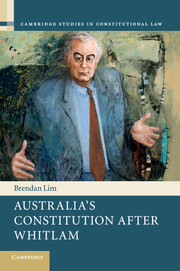3 - The Whitlam Dismissal
Published online by Cambridge University Press: 06 April 2017
Summary
On 11 November 1975, the Governor-General, Sir John Kerr, sacked the Whitlam government, intervening to end an unprecedented supply deadlock between the two Houses of Parliament. He commissioned the Leader of the Opposition, Malcolm Fraser, to form a caretaker government. An election would be held on 13 December. Kerr defended his action as ‘a democratic and constitutional solution to the current crisis which will permit the people of Australia to decide as soon as possible what should be the outcome of the deadlock’.
‘Permit the people of Australia to decide.’ Kerr's invocation of popular sovereignty signified what was at stake in the conflict between the Whitlam government and the opposition-controlled Senate. It was a conflict about the character of Australia's popular sovereignty and the proper role and authority of the people in legitimating the informal constitutional changes that the Whitlam government was systematically setting out to implement. Whitlam thought that the people had already decided, when they returned his government at successive national elections in 1972 and 1974. For the Senate, ultimately backed by the Governor-General, that was not enough. The Senate perceived Whitlam to be claiming more authority than those ordinary elections could confer. It perceived Whitlam to be claiming the authority to change settled norms outside of a prescribed referendum procedure for constitutional change. The Senate's assertion of a right to withhold supply in order to force further elections functioned as a technique of constitutional preservation – a means not so much to destroy Whitlam's constitutional innovations as to delay them, and to test them against the will of a legally sovereign people. The real constitutional crisis was defined by the fundamentally incompatible conceptions of the people, and of legitimate constitutional change, which Whitlam and the Senate each articulated in defence of their respective positions. Kerr's intervention, right or wrong, meant that the real crisis was left entirely unresolved. I set out in this chapter to defend these claims and to recast the events of 1972–1975 in light of what I identify as the real constitutional crisis: the conflict over legitimate techniques of informal constitutional change. Before I can do that, it is necessary to begin with the standard narrative.
- Type
- Chapter
- Information
- Australia's Constitution after Whitlam , pp. 36 - 90Publisher: Cambridge University PressPrint publication year: 2017

